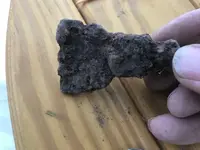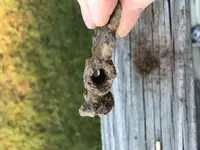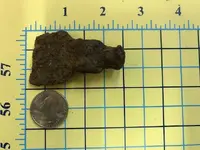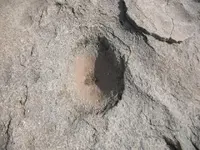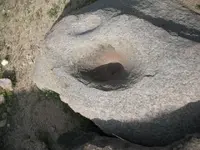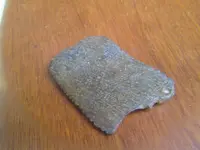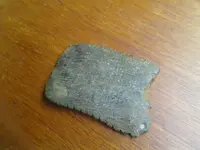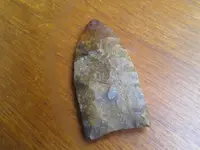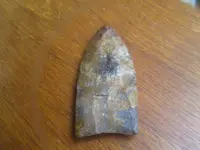You are using an out of date browser. It may not display this or other websites correctly.
You should upgrade or use an alternative browser.
You should upgrade or use an alternative browser.
Lets see what you consider your rarest personal find...
- Thread starter mainejman
- Start date
Ammoman
Bronze Member
- Joined
- May 28, 2010
- Messages
- 20,279
- Reaction score
- 32,201
- Golden Thread
- 1
- Location
- White Plains, New York
- 🥇 Banner finds
- 1
- 🏆 Honorable Mentions:
- 1
- Detector(s) used
- Nokta Makro Legend// Pulsedive// Minelab GPZ 7000// Vanquish 540// Minelab Pro Find 35// Dune Kraken Sandscoop// Grave Digger Tools Tombstone shovel & Sidekick digger// Bunk's Hermit Pick
- Primary Interest:
- Metal Detecting
Yavapai Stuff
Don't know what the grinding stones are called, but other than arrow heads, this was my best discovery.
Don't know what the grinding stones are called, but other than arrow heads, this was my best discovery.

Attachments
Old Pueblo
Bronze Member
They're called bedrock mortars. Its always cool finding those out and about.
So is this thing Native American? It looks pretty amazing to me! Id love to know more about it and the people who made it.
This is from the Central States Archaeological Journal of April 2015. Our friend Rock was kind enough to mail me this magazine. For some reason the pictures did not down load but, here is the write up;
A Vulture Effigy Pipe From Lee County, Georgia
By Lloyd E. Schroder
The pipe is made of shell-tempered pottery, a strong indication that it is part of the Mississippian period culture. It was found in close association with both Lamar Complicated Stamped (left) and Lamar Bold Incised pottery (right) that dates to the Late Mississippian period, probably between 1350 and 1450 A.D. The date of the pipe is early enough to retain the Quincunx or cross-in-circle symbol of the Southeastern Ceremonial Complex. The Cross in Circle Motif is prevalent in most Native American religions. It has solar connotationsand usually symbolizes the sacred fire that exists in the Middle World. A Cross in Circle Motif combined with a Petaloid Motif symbolized the Above World. The arches with lines and punctations are one of the many Cool Branch Incised design variations. Frank T. and Gail S. Schnell and Vernon J. Knight Jr. (Cemochechobee 1981) gave no suggestion of a symbolic meaning of the arches. Cool Branch pottery was made during the Middle and Late Mississippian periods between 1200 and 1400 A.D. The Vulture eating a human head effigy is clearly a death theme. The sacred fire may continue that theme into the upper world. Neither Lamar or Cool Branch pottery was shell tempered, but many other Late Mississippian pottery types in the central Chattahoochee River were.
Old Pueblo
Bronze Member
This is from the Central States Archaeological Journal of April 2015. Our friend Rock was kind enough to mail me this magazine. For some reason the pictures did not down load but, here is the write up;
A Vulture Effigy Pipe From Lee County, Georgia
By Lloyd E. SchroderI recently had the privilege of getting to know one of our newest friends through the Peach State Archaeological Society web site. I will honor his request by not sharing his name in this report, but his story is one that resonates with many of our members that have used our hobby of artifact collecting as a meaningful way to spend time with family members. Our friend shared with me that he and his family had taken a trip to the Kinchafoonee Creek area in Lee County, Georgia to find some relief from the 101 degree heat on July 1, 2012. The temperatures that summer had been so consistently hot and the drought so severe that the level of the creek was extremely low. The irrigation needs of local farms had further driven water tables to a record low. While standing near the creek, he had noticed a few chips of flint and some sherds of pottery that were visible in the shallow water. His eye then caught a piece of, what appeared to be drift wood, half submerged in the sandy bottom of the creek. You can imagine his surprise when he lifted the “drift wood” out of the water, discovering that it was not only a clay pipe, but that it was a “buzzard holding a human head!” After 35 years of collecting and many nice finds, the Vulture effigy pipe was the find of a lifetime for our friend. While he is proud of his find and more than happy to share it with us through this article and through our web site, he is clearly not interested in selling the pipe. He wants to leave it to his daughter for her future enjoyment.Lamar Complicated Stamped pottery (left) and Lamar Bold Incised pottery (right) were found within a few feet of the Vulture effigy pipe.
The pipe is made of shell-tempered pottery, a strong indication that it is part of the Mississippian period culture. It was found in close association with both Lamar Complicated Stamped (left) and Lamar Bold Incised pottery (right) that dates to the Late Mississippian period, probably between 1350 and 1450 A.D. The date of the pipe is early enough to retain the Quincunx or cross-in-circle symbol of the Southeastern Ceremonial Complex. The Cross in Circle Motif is prevalent in most Native American religions. It has solar connotationsand usually symbolizes the sacred fire that exists in the Middle World. A Cross in Circle Motif combined with a Petaloid Motif symbolized the Above World. The arches with lines and punctations are one of the many Cool Branch Incised design variations. Frank T. and Gail S. Schnell and Vernon J. Knight Jr. (Cemochechobee 1981) gave no suggestion of a symbolic meaning of the arches. Cool Branch pottery was made during the Middle and Late Mississippian periods between 1200 and 1400 A.D. The Vulture eating a human head effigy is clearly a death theme. The sacred fire may continue that theme into the upper world. Neither Lamar or Cool Branch pottery was shell tempered, but many other Late Mississippian pottery types in the central Chattahoochee River were.
That is one amazing find for sure. I always enjoy learning about artifacts. People tend to think of our Native American cousins as being very primitive, but artifacts like these show they were very much an intelligent, thinking people. Part of the reason I love the Southwest so much, with all of our ancient Indian ruins and irrigation canals and so forth. They were some truly amazing people.
tamrock
Platinum Member
I wonder if that's made of Minnesota Pipestone? I went to where the red Rock quarries are once.Hands down this is mine.View attachment 1506761
quito
Silver Member
- Joined
- Mar 31, 2008
- Messages
- 4,626
- Reaction score
- 4,844
- Golden Thread
- 0
- Location
- south dakota
- Detector(s) used
- good eyes
I wonder if that's made of Minnesota Pipestone? I went to where the red Rock quarries are once.
Sure looks like pipestone to me. I live within a couple dozen miles of Pipestone Minn. it's not uncommon here.
tnmudman
Hero Member
- Joined
- Feb 12, 2017
- Messages
- 704
- Reaction score
- 1,537
- Golden Thread
- 0
- Location
- middle tennessee
- Primary Interest:
- Relic Hunting
Ammoman I think that may be a hatchet/hammer possibly from the colonial or trade era , so it could have belonged to an indian, though it was made by white men. That is just my guess.
yakker
Bronze Member
quito
Silver Member
- Joined
- Mar 31, 2008
- Messages
- 4,626
- Reaction score
- 4,844
- Golden Thread
- 0
- Location
- south dakota
- Detector(s) used
- good eyes
Two nice pieces yakker
Old Pueblo
Bronze Member
Sorry about posting my tooth on this thread...i just looked at the title and posted without noticing it was North American Indian artifacts. that said, This May be my rarest Indian Artifact find.
It was suggested this may be a tomahawk.
I would love any input for or against the suggestion.
View attachment 1507328 View attachment 1507329 View attachment 1507330
Thats an axe head for sure. Awesome find. Maybe one of those fur trade artifacts?
brandybobo1973
Tenderfoot
- Joined
- Oct 15, 2017
- Messages
- 3
- Reaction score
- 0
- Golden Thread
- 0
- Primary Interest:
- All Treasure Hunting
Dude what is that !! Is it someones finger ??
It’s a tooth with a filling, the long part is the root. Just in case the question has not been answered yet.
Sent from my iPad using Tapatalk
brandybobo1973
Tenderfoot
- Joined
- Oct 15, 2017
- Messages
- 3
- Reaction score
- 0
- Golden Thread
- 0
- Primary Interest:
- All Treasure Hunting
Not sure what it was used for, neither are the state archeologist or any of his peers.
View attachment 1506633
View attachment 1506634View attachment 1506635
It looks like a ‘notch tool’ to me. Like Notching out the edges of a spear tip, or sharpening the edges maybe, is what I mean. Something like that...I am guessing here. What do you think?
Sent from my iPad using Tapatalk
quito
Silver Member
- Joined
- Mar 31, 2008
- Messages
- 4,626
- Reaction score
- 4,844
- Golden Thread
- 0
- Location
- south dakota
- Detector(s) used
- good eyes
Welcome aboard brandybobo
i think the edge was grooved to provided for a better grip. The opposing ends are so highly polished it had to have been doing a lot of rubbing on something.
i think the edge was grooved to provided for a better grip. The opposing ends are so highly polished it had to have been doing a lot of rubbing on something.
jamus peek
Sr. Member
- Joined
- May 13, 2014
- Messages
- 373
- Reaction score
- 334
- Golden Thread
- 0
- Primary Interest:
- All Treasure Hunting
Here is a rare find of mine it is a creek find. It is a phallic plummet/charmstone. I have found a few but this one is a big one almost 8 inches. The glans were used as the groove. It could have also been used as a mano because one side is flattened. The last pic shows some possible paint flakes still intact.












Attachments
Last edited:
SpectateSwamp
Tenderfoot
- Joined
- Oct 27, 2017
- Messages
- 1
- Reaction score
- 0
- Golden Thread
- 0
- Primary Interest:
- All Treasure Hunting
Sacred Medicine Stone maybe?
This stone popped out of a gravel crusher in 1972..
I have 2 others that are almost as cool.
This stone popped out of a gravel crusher in 1972..
I have 2 others that are almost as cool.
DigIron2
Silver Member
You guys have some very nice stuff.Mine would probably be this claystone gorget and the fresh water pearl. The gorget is a personal find but I didn't find it in the field. I found under my granddads bed in a cigar box after he passed. The pearl I found on A Archaic site. It looks like it was half polished before it was lost.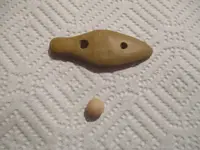
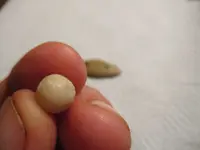


Similar threads
- Replies
- 6
- Views
- 864
- Suggestion
- Replies
- 16
- Views
- 2K
- Replies
- 4
- Views
- 603
Users who are viewing this thread
Total: 1 (members: 0, guests: 1)



